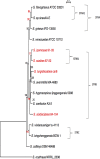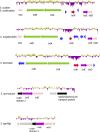Genome Content and Phylogenomics Reveal both Ancestral and Lateral Evolutionary Pathways in Plant-Pathogenic Streptomyces Species
- PMID: 26826232
- PMCID: PMC4807529
- DOI: 10.1128/AEM.03504-15
Genome Content and Phylogenomics Reveal both Ancestral and Lateral Evolutionary Pathways in Plant-Pathogenic Streptomyces Species
Abstract
Streptomyces spp. are highly differentiated actinomycetes with large, linear chromosomes that encode an arsenal of biologically active molecules and catabolic enzymes. Members of this genus are well equipped for life in nutrient-limited environments and are common soil saprophytes. Out of the hundreds of species in the genus Streptomyces, a small group has evolved the ability to infect plants. The recent availability of Streptomyces genome sequences, including four genomes of pathogenic species, provided an opportunity to characterize the gene content specific to these pathogens and to study phylogenetic relationships among them. Genome sequencing, comparative genomics, and phylogenetic analysis enabled us to discriminate pathogenic from saprophytic Streptomyces strains; moreover, we calculated that the pathogen-specific genome contains 4,662 orthologs. Phylogenetic reconstruction suggested that Streptomyces scabies and S. ipomoeae share an ancestor but that their biosynthetic clusters encoding the required virulence factor thaxtomin have diverged. In contrast, S. turgidiscabies and S. acidiscabies, two relatively unrelated pathogens, possess highly similar thaxtomin biosynthesis clusters, which suggests that the acquisition of these genes was through lateral gene transfer.
Copyright © 2016, American Society for Microbiology. All Rights Reserved.
Figures







Similar articles
-
What does it take to be a plant pathogen: genomic insights from Streptomyces species.Antonie Van Leeuwenhoek. 2010 Aug;98(2):179-94. doi: 10.1007/s10482-010-9429-1. Epub 2010 Apr 17. Antonie Van Leeuwenhoek. 2010. PMID: 20396949 Review.
-
Thaxtomin biosynthesis: the path to plant pathogenicity in the genus Streptomyces.Antonie Van Leeuwenhoek. 2008 Jun;94(1):3-10. doi: 10.1007/s10482-008-9240-4. Epub 2008 Apr 5. Antonie Van Leeuwenhoek. 2008. PMID: 18392685
-
A large, mobile pathogenicity island confers plant pathogenicity on Streptomyces species.Mol Microbiol. 2005 Feb;55(4):1025-33. doi: 10.1111/j.1365-2958.2004.04461.x. Mol Microbiol. 2005. PMID: 15686551
-
nec1, a gene conferring a necrogenic phenotype, is conserved in plant-pathogenic Streptomyces spp. and linked to a transposase pseudogene.Mol Plant Microbe Interact. 1998 Oct;11(10):960-7. doi: 10.1094/MPMI.1998.11.10.960. Mol Plant Microbe Interact. 1998. PMID: 9768513
-
Evolution of plant pathogenicity in Streptomyces.Annu Rev Phytopathol. 2006;44:469-87. doi: 10.1146/annurev.phyto.44.032905.091147. Annu Rev Phytopathol. 2006. PMID: 16719719 Review.
Cited by
-
Nigericin and Geldanamycin Are Phytotoxic Specialized Metabolites Produced by the Plant Pathogen Streptomyces sp. 11-1-2.Microbiol Spectr. 2022 Apr 27;10(2):e0231421. doi: 10.1128/spectrum.02314-21. Epub 2022 Feb 28. Microbiol Spectr. 2022. PMID: 35225656 Free PMC article.
-
Within-Species Genomic Variation and Variable Patterns of Recombination in the Tetracycline Producer Streptomyces rimosus.Front Microbiol. 2019 Mar 21;10:552. doi: 10.3389/fmicb.2019.00552. eCollection 2019. Front Microbiol. 2019. PMID: 30949149 Free PMC article.
-
High diversity and suggested endemicity of culturable Actinobacteria in an extremely oligotrophic desert oasis.PeerJ. 2017 May 2;5:e3247. doi: 10.7717/peerj.3247. eCollection 2017. PeerJ. 2017. PMID: 28480140 Free PMC article.
-
Comparative Genomics of Potato Common Scab-Causing Streptomyces spp. Displaying Varying Virulence.Front Microbiol. 2021 Aug 3;12:716522. doi: 10.3389/fmicb.2021.716522. eCollection 2021. Front Microbiol. 2021. PMID: 34413844 Free PMC article.
-
A PL1 family pectate lyase CP966_RS08110 gene was the pathogenic factor of Streptomyces galilaeus 5T-1 causing potato common scab.Front Microbiol. 2024 Nov 27;15:1469709. doi: 10.3389/fmicb.2024.1469709. eCollection 2024. Front Microbiol. 2024. PMID: 39664058 Free PMC article.
References
-
- Bentley SD, Chater KF, Cerdeño-Tárraga A-M, Challis GL, Thomson NR, James KD, Harris DE, Quail MA, Kieser H, Harper D, Bateman A, Brown S, Chandra G, Chen CW, Collins M, Cronin A, Fraser A, Goble A, Hidalgo J, Hornsby T, Howarth S, Huang C-H, Kieser T, Larke L, Murphy L, Oliver K, O'Neil S, Rabbinowitsch E, Rajandream M-A, Rutherford K, Rutter S, Seeger K, Saunders D, Sharp S, Squares R, Squares S, Taylor K, Warren T, Wietzorrek A, Woodward J, Barrell BG, Parkhill J, Hopwood DA. 2002. Complete genome sequence of the model actinomycete Streptomyces coelicolor A3(2). Nature 417:141–147. doi:10.1038/417141a. - DOI - PubMed
-
- Omura S, Ikeda H, Ishikawa J, Hanamoto A, Takahashi C, Shinose M, Takahashi Y, Horikawa H, Nakazawa H, Osonoe T, Kikuchi H, Shiba T, Sakaki Y, Hattori M. 2001. Genome sequence of an industrial microorganism Streptomyces avermitilis: deducing the ability of producing secondary metabolites. Proc Natl Acad Sci U S A 98:12215–12220. doi:10.1073/pnas.211433198. - DOI - PMC - PubMed
Publication types
MeSH terms
Substances
LinkOut - more resources
Full Text Sources
Other Literature Sources
Molecular Biology Databases
Miscellaneous

